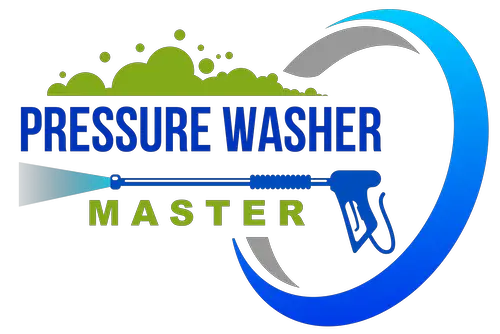Is there anything on your deck that needs to be replaced? Do you wish you could demolish it and replace it with a fresh, more attractive specimen? The good news is that you don’t have to do this to find a deck you like. In many situations, simply stripping it down and staining it can give it a brand-new look you desire for a fraction of the cost.
Many individuals, however, are skeptical about this choice. They believe it takes the same amount of time and money to replace the deck to create a new one. Pressure washing deck before staining, contrary to popular belief, makes stripping your deck a lot easier than it appears.
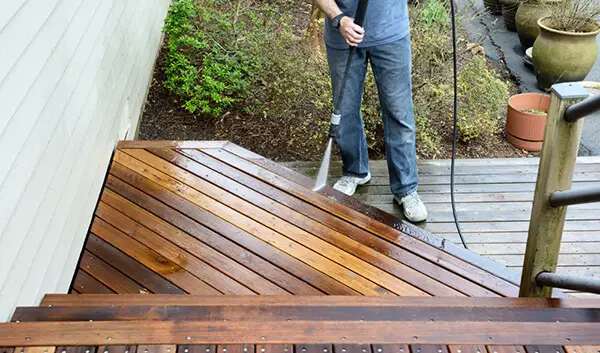
Continue reading to determine how pressure washing may help you remove old paint, wood stain, ground-in dirt, and even mold and mildew from your deck.
Should You Consider Pressure Washing Deck Before Staining?
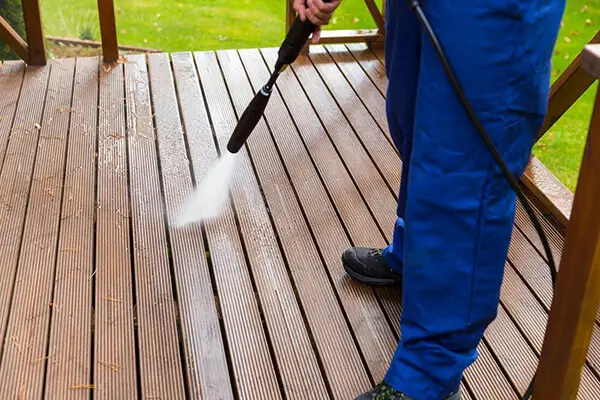
Although we may be biased, the answer is definitely yes! A win-win situation is achieved by pressure cleaning the deck or patio surface before staining.
By not having to clean the deck by hand, you save time and back-breaking work. In addition, low-pressure water hoses can only deal with relatively superficial areas of concern on the deck so that you can penetrate the surface much deeper and more effortless.
A side-by-side examination of a hose-clean deck against a pressure-washed deck will reveal the truth. It looks brand new after being pressure washed, removing years of neglect and usage.
Additionally, pressure washing can assist in removing the layer of other paint and stain, leaving a fully naked surface ready to be used. Pressure washing also prolongs the life of the deck paint and stain that will be applied later.
Cleaning the spaces between the deck boards may be accomplished by removing everything in one quick pass, which is much more challenging to do with a brush and hand. In addition, cleaning between the boards helps reduce the risks of fungal development and dirt formation.
You see, there are two primary techniques to get the most excellent prep before staining a deck: one that takes time and doesn’t offer you the thorough clean you need, and one that is faster, easier, and gives your surface new life and a brighter future. So which one are you going to pick?
How To Pressure Wash Deck Before Staining
So, if you just go out and purchase a pressure washer and start cleaning with it, you could find that your lovely flat wooden board starts to resemble a seashell. Regrettably, this is a permanent problem.
A pressure washer generates a significant quantity of force. Isn’t that why we adore them? However, if you are not paying attention or are in a rush, you can become harmed or cause damage.
Taking your time might end up saving you time, money, and your health in the long run.
Safety Precautions
The most important thing to remember is to avoid major injury. You should wear goggles or other eye protection and closed-toe shoes. Keep people away from the direct spray. Do not aim the nozzle towards anybody or anything.
Shorts, loose clothes, and jewelry are all things to avoid.
When utilizing a gas power washer, keep in mind that the engine heats up with time, so be cautious when moving it.
Prepare The Site
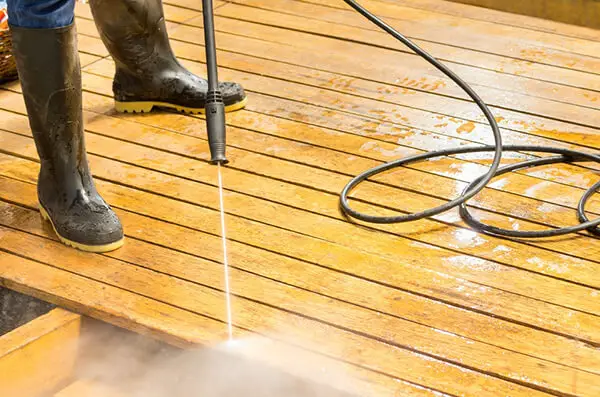
You should remove all loose material from the area around the deck. To avoid tripping and tangling hoses, eliminate any impediments in the way. Prepare your work environment so you can concentrate on the cleaning task at hand and avoid being sidetracked by annoying barriers that stifle your productivity. Wind may be a distraction at times, so keep an eye on the forecast.
Use Cleaners Carefully
To begin, follow the manufacturer’s setup instructions. Then, to get a good spray pattern for your hardwood deck, look at the washer’s manual option. Now, using a low-pressure soap-dispensing nozzle, add the solution as needed. Then turn the machine on and spray the solution from the top.
Use A Utility Brush And A Rotating Scrub Brush
Use a utility brush to apply the solution in usual spots and tight corners. The utility brush should be made of synthetic material and have a long handle. The long handle will make it easier to reach all of those hard-to-reach filthy spots. Heavy areas and dirt are removed using a revolving scrub brush.
Rinse
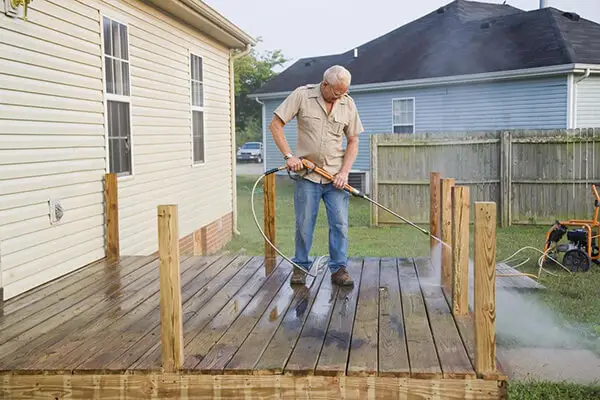
Move the trigger at the optimum angle with the conventional widest nozzle. The usual degree of angle from where the water emerges is between 40 and 60 degrees. You should be concerned about the amount of pressure you applied. Washing with a high-pressure washer will etch the wood. The harm is irreversible, and there is no way to reverse it.
For softwood, use 500-600 psi (pounds per square inch), while for more challenging wood, use 1200 psi or less. Maintain a 6-foot distance between the nozzle and the deck surface.
You generally don’t need to pressure wash a newly installed deck if you’re staining it. Instead, all the deck needs is a good mopping with a deck cleaning solution and a good washing with a hose and water.
You may use the same cleaning solution on an old or unclean deck that can be harmed by high-pressure spray, but you’ll have to scrub the deck with a stiff brush after letting the solution sit for a few minutes. If your deck is more than 100 square feet, hiring a flooring orbital sander will save you time and work.
How To Sanding After Pressure Washing Deck
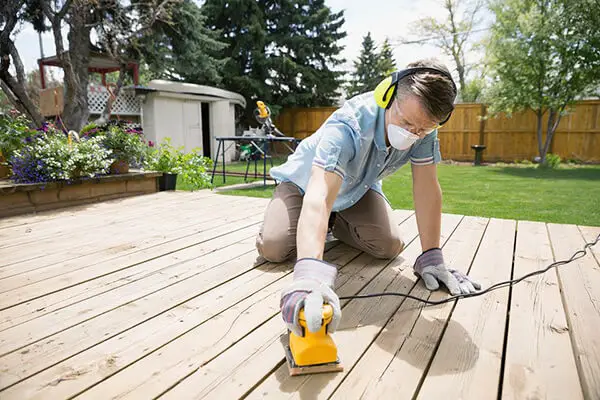
A power wash deck before staining should not damage the wood or etch or dissolve the softwood fibers. However, when wood is wet, the fibers rise to the surface, resulting in a rough surface. Raised fibers on handrails can cause splinters. Before sanding, make sure the wood is dry.
You have a few choices for dealing with this issue. First, you might be able to get away with a spot-sanding here and there if you performed a fantastic job power washing with minimum damage and you just want to clean the deck.
However, if you want to refinish (re-stain or re-seal) the deck, you’ll need to sand the whole deck to produce smooth, splinter-free planks. Sanding also opens up the pores in the wood, allowing it to absorb the sealer or stain evenly.
Avoid using very fine sandpaper when sanding since this might clog the wood’s pores, preventing the stain/sealer from soaking in correctly.
Use no finer than 100-grit sandpaper for the handrail. Use sandpaper with a 60- to 80-grit rating for the deck’s surface. A random orbit sander with a 5-inch sanding pad is the ideal sander for a wood deck.
Check out this video for more detailed instructions:
Conclusion
Your deck should be as good as new now that you know how to pressure washing deck before staining. Make sure you complete all of the steps. Prepare the area by inspecting the nails, cleaning the deck, and selecting the appropriate settings.
Then, instead of walking over it, start washing along the grain, making your way back to the exit. Finally, to remove mold, mildew, or dark stains, apply a stripping or whitening solution.
You may have to sand the decking down as well. If not, wait until the decking is completely dry before replacing your furniture and enjoying your sparkling new deck!
Related Post
